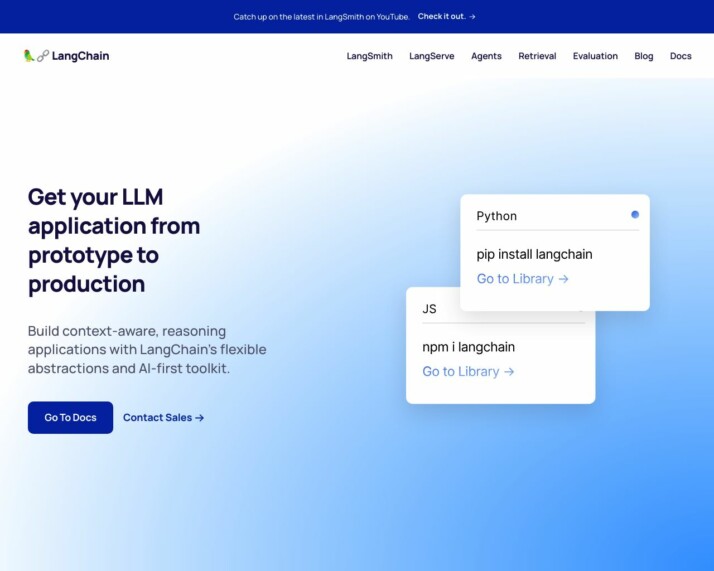LangChain vs. Beam AI: Comparing AI Development Platforms
AI development platforms shape the future of intelligent applications, offering developers and businesses powerful tools to harness language models and create sophisticated AI solutions. This comparison explores LangChain vs. Beam AI, and SmythOS, three distinct approaches to AI development and automation. LangChain provides an open-source framework for building large language model (LLM) applications, while Beam AI specializes in task-specific AI agents for business process automation. SmythOS emerges as a comprehensive platform combining the strengths of both, with a user-friendly interface and enterprise-grade features. We’ll examine each platform’s core capabilities, development tools, deployment options, and security features to help you choose the best solution for your AI development needs.
LangChain Overview
LangChain revolutionizes the development of large language model (LLM) applications with its comprehensive open-source framework. This platform empowers developers to create sophisticated AI-powered solutions by providing essential building blocks and integrations. LangChain’s versatility shines through its support for various stages of LLM application development, from initial coding to deployment and monitoring.
LangChain offers a rich ecosystem of tools designed to streamline the creation of LLM-based applications. Its core components include LangGraph for building stateful, multi-actor systems, LangSmith for rigorous testing and evaluation, and LangServe for seamless API deployment. These tools work in concert to facilitate the development of AI agents capable of complex problem-solving and human-like interactions.


LangChain’s Expression Language (LCEL) introduces a declarative method for chaining components, offering benefits like streaming support and optimized parallel execution.
The platform’s strength lies in its modular approach, allowing developers to mix and match components to suit their specific needs. LangChain’s Expression Language (LCEL) introduces a declarative method for chaining components, offering benefits like streaming support and optimized parallel execution. This flexibility, combined with extensive integration options, positions LangChain as a powerful choice for developers seeking to harness the full potential of LLMs.
While LangChain excels in providing a robust framework for LLM application development, it may present a steeper learning curve for those new to AI development. The platform’s focus on flexibility and customization can require a deeper understanding of LLMs and programming concepts. Additionally, as an open-source project, LangChain’s support structure may differ from commercial alternatives, potentially impacting users who require extensive hand-holding or immediate assistance.
LangChain’s commitment to the open-source model fosters a collaborative environment where developers can contribute to and benefit from a growing ecosystem of tools and integrations. This approach not only accelerates innovation but also ensures that the platform remains at the cutting edge of LLM technology. As AI continues to evolve, LangChain’s adaptable framework positions it as a key player in shaping the future of intelligent applications.
Beam AI Overview
Beam AI specializes in creating generative AI agents that automate repetitive manual tasks for organizations. Their Agentic Process Automations (APAs) boost productivity by handling data extraction, customer inquiries, compliance tasks, and order processing more efficiently than humans. These AI agents continuously learn and adapt, improving their accuracy and speed over time.


Beam AI specializes in creating generative AI agents that automate repetitive manual tasks for organizations. Their Agentic Process Automations (APAs) boost productivity by handling data extraction, customer inquiries, compliance tasks…
The platform focuses on back-office automation, customer service, compliance, and order processing. Beam AI’s solutions are tailored to meet specific organizational needs, emphasizing sustainability and efficiency. Their AI-native approach aims to minimize steps in achieving goals and reduce human carbon footprints.
Beam AI equips its agents with advanced conversational interfaces for seamless interaction and efficient task management. These agents integrate with existing internal systems to plan and execute workflows, providing comprehensive automation solutions. The company’s vision centers on creating a sustainable and ethical future using AI, with a mission to build agents capable of tackling complex workflows and improving through continuous learning.
The company’s vision centers on creating a sustainable and ethical future using AI, with a mission to build agents capable of tackling complex workflows and improving through continuous learning.
While Beam AI offers powerful automation capabilities, it may lack some features found in more comprehensive platforms. The absence of a visual builder or no-code editor could limit accessibility for non-technical users. Additionally, there’s no mention of specific debugging tools or multi-agent collaboration features, which might be essential for complex AI deployments.
Beam AI’s focus on specific use cases like back-office automation and customer service may appeal to businesses looking for targeted solutions. However, organizations requiring more versatile AI development tools or extensive customization options might find the platform’s offerings somewhat limited. The company’s emphasis on sustainability and efficiency aligns well with modern business priorities, potentially making it an attractive option for environmentally conscious enterprises.
Feature Comparison
LangChain and Beam AI offer distinct approaches to AI development, with notable differences in their core components and security features. LangChain provides a comprehensive framework for building LLM applications, including tools like LangGraph for creating stateful, multi-actor systems. It excels in offering extensive integration options and support for various AI models. LangChain’s LangSmith enhances transparency and debugging capabilities, allowing developers to trace, monitor, and evaluate their LLM applications effectively.
In contrast, Beam AI focuses on creating specialized AI agents for task automation, particularly in areas like back-office operations and customer service. While Beam AI emphasizes continuous learning and adaptation of its agents, it lacks some of the development tools and flexibility that LangChain offers. LangChain’s support for multimodal inputs and its Expression Language (LCEL) for component chaining give it an edge in versatility. However, Beam AI’s targeted approach to specific use cases like compliance and order processing may appeal to businesses seeking ready-to-deploy solutions in these areas.
The security features of both platforms also differ. LangChain emphasizes best practices in security, likely including data encryption, and supports OAuth for API authentication. Beam AI’s documentation doesn’t explicitly detail its security measures, which could be a concern for organizations dealing with sensitive data. LangChain’s more transparent approach to security and its broader set of development tools make it a stronger choice for developers who require fine-grained control over their AI applications’ security and functionality.
Feature Comparison Table
| LangChain | Beam AI | SmythOS | |
|---|---|---|---|
| CORE FEATURES | |||
| Visual Builder | ❌ | ❌ | ✅ |
| No-Code Options | ❌ | ❌ | ✅ |
| Debug Tools | ✅ | ❌ | ✅ |
| Multimodal | ✅ | ❌ | ✅ |
| Agent Work Scheduler | ❌ | ✅ | ✅ |
| SECURITY | |||
| Constrained Alignment | ❌ | ✅ | ✅ |
| IP Control | ❌ | ✅ | ✅ |
| COMPONENTS | |||
| Zapier APIs | ❌ | ✅ | ✅ |
| Data Lakes | ❌ | ❌ | ✅ |
| DEPLOYMENT OPTIONS (EMBODIMENTS) | |||
| Deploy as Webhook | ❌ | ✅ | ✅ |
| Staging Domains | ❌ | ✅ | ✅ |
| Production Domains | ❌ | ✅ | ✅ |
| Deploy as Scheduled Agent | ❌ | ✅ | ✅ |
| DATA LAKE SUPPORT | |||
| Hosted Vector Database | ❌ | ❌ | ✅ |
| Sitemap Crawler | ❌ | ❌ | ✅ |
| YouTube Transcript Crawler | ❌ | ❌ | ✅ |
| URL Crawler | ❌ | ❌ | ✅ |
| Word File Support | ❌ | ✅ | ✅ |
Best Alternative to LangChain and Beam AI
SmythOS stands out as the premier alternative to LangChain and Beam AI, offering a comprehensive agentic AI automation platform that surpasses its competitors in ease of use, feature set, and versatility. Our platform empowers users to create and deploy sophisticated AI agents without the steep learning curve associated with other solutions.
SmythOS stands out as the premier alternative to LangChain and Beam AI, offering a comprehensive agentic AI automation platform that surpasses its competitors in ease of use, feature set, and versatility.
Unlike LangChain’s focus on developer-centric tools and Beam AI’s specialized approach, SmythOS provides a user-friendly visual builder that democratizes AI development. This drag-and-drop interface allows both technical and non-technical users to construct complex AI workflows effortlessly, significantly reducing the time and expertise required to bring AI solutions to life.
SmythOS excels in its extensive integration capabilities, supporting a wide array of AI models, APIs, and data sources. While LangChain offers some integration options, SmythOS takes it further by providing pre-built connectors and templates that streamline the development process. This robust ecosystem enables users to tap into powerful AI functionalities and seamlessly incorporate them into existing business processes.
Our platform’s multi-agent orchestration capabilities set it apart from both LangChain and Beam AI. SmythOS allows for the creation of collaborative AI systems, where multiple agents work together to tackle complex tasks. This feature, combined with our advanced debugging tools and transparent workflows, ensures that users can build and manage sophisticated AI solutions with confidence and clarity.
Furthermore, SmythOS offers unparalleled flexibility in deployment options. Whether you need to deploy your AI agents as APIs, chatbots, scheduled tasks, or integrate them with popular platforms like ChatGPT, our system provides the versatility to meet diverse use cases. This adaptability, coupled with our commitment to scalability and security, makes SmythOS the ideal choice for businesses of all sizes looking to harness the power of AI efficiently and effectively.
Conclusion
LangChain, Beam AI, and SmythOS each offer unique approaches to AI development and automation. LangChain provides a comprehensive open-source framework for building LLM applications, excelling in flexibility and integration options. Beam AI focuses on specialized AI agents for task automation, particularly in back-office operations and customer service. However, SmythOS emerges as the superior choice, combining the strengths of both while addressing their limitations.
SmythOS stands out with its user-friendly drag-and-drop interface, extensive integration ecosystem, and versatile deployment options. Unlike LangChain’s steeper learning curve or Beam AI’s limited customization, SmythOS democratizes AI development, making it accessible to both technical and non-technical users. Its support for multi-agent orchestration, pre-built API integrations, and templates significantly reduces development time and complexity.
The platform’s ability to deploy AI agents across various environments, from APIs to chatbots and scheduled tasks, offers unparalleled flexibility. SmythOS also addresses security concerns with robust features like data encryption and OAuth support, ensuring enterprise-grade protection for sensitive information.
For businesses and developers seeking to harness the full potential of AI, SmythOS provides the ideal balance of power, ease of use, and scalability. Explore our diverse range of AI-powered agent templates to kickstart your AI journey, or create a free SmythOS account to experience the future of AI development firsthand. With SmythOS, you’re not just building AI agents; you’re unlocking a new era of intelligent automation and innovation.
Last updated:
Disclaimer: The information presented in this article is for general informational purposes only and is provided as is. While we strive to keep the content up-to-date and accurate, we make no representations or warranties of any kind, express or implied, about the completeness, accuracy, reliability, suitability, or availability of the information contained in this article.
Any reliance you place on such information is strictly at your own risk. We reserve the right to make additions, deletions, or modifications to the contents of this article at any time without prior notice.
In no event will we be liable for any loss or damage including without limitation, indirect or consequential loss or damage, or any loss or damage whatsoever arising from loss of data, profits, or any other loss not specified herein arising out of, or in connection with, the use of this article.
Despite our best efforts, this article may contain oversights, errors, or omissions. If you notice any inaccuracies or have concerns about the content, please report them through our content feedback form. Your input helps us maintain the quality and reliability of our information.
